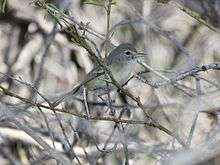Bell's vireo
| Bell's vireo | |
|---|---|
 | |
| Scientific classification | |
| Kingdom: | Animalia |
| Phylum: | Chordata |
| Class: | Aves |
| Order: | Passeriformes |
| Family: | Vireonidae |
| Genus: | Vireo |
| Species: | V. bellii |
| Binomial name | |
| Vireo bellii Audubon, 1844 | |

Bell's vireo (Vireo bellii)[2] is a small North American songbird. It is 4.75 to 5 in (12.1 to 12.7 cm) in length, dull olive-gray above and whitish below. It has a faint white eye ring and faint wing bars.
This bird was named by Audubon for John Graham Bell, who accompanied him on his trip up the Missouri River in the 1840s.
The least Bell's vireo (Vireo bellii pusillus), is an endangered subspecies in Southern California. Consideration of Bell's vireo has been a factor in several land development projects, to protect least Bell's vireo habitat. The decline of the least Bell's vireo is mostly due to a loss of riparian habitat and brood parasitism by the brown-headed cowbird (Molothrus ater).
Behavior and ecology
Bell's vireo makes a well-camouflaged nest but when found the bird will stand its ground against intruders. cowbirds use Bell's vireo nests as their own nurseries. Bell's vireo often uses dense shrubbery including willows (Salix spp.), mulefat (Baccharis glutinosa), California wild rose (Rosa californica), mugwort (Artemisia douglasiana), Fremont cottonwood (Populus fremontii), and Western poison oak (Toxicodendron diversilobum) shrubs or vines as nesting locations.[3][4]
Historically, the least Bell's vireo was a common to locally abundant species in lowland riparian habitat, ranging from coastal southern California through the Sacramento and San Joaquin Valleys as far north as Red Bluff in Tehama County. Populations also occurred in the foothill streams of the Sierra Nevada and Coast Ranges, and in Owens Valley, Death Valley, and scattered locations in the Mojave Desert. Least Bell's vireos winter in Baja California Peninsula. Unlike during the breeding season, they are not limited in winter to willow-dominated riparian areas, but occupy a variety of habitats including mesquite scrub within arroyos, palm groves, and hedgerows bordering agricultural and residential areas. At the time of endangered species listing by the U.S. Fish and Wildlife Service in 1986, it had been extirpated from most of its historic range, and numbered just 300 pairs statewide. Populations were confined to eight counties south of Santa Barbara, with the majority of birds occurring in San Diego County. In the decade since listing, least Bell's vireo numbers have increased six-fold, and the species is expanding into its historic range. In 1998, the population size was estimated at 2,000 pairs. Nesting vireos have recolonized the Santa Clara River in Ventura County, where 67 pairs nested in 1998, and the Mojave River in San Bernardino County. The northernmost reported sighting in recent years is of a nesting pair of vireos near Gilroy in Santa Clara County in 1997. Roughly half of the current vireo population occurs on drainages within Marine Corps Base Camp Pendleton in San Diego County, particularly in the lower Santa Margarita River.[3]
References
- ↑ BirdLife International (2012). "Vireo bellii". IUCN Red List of Threatened Species. Version 2013.2. International Union for Conservation of Nature. Retrieved 26 November 2013.
- ↑ "Species factsheet: Vireo bellii". BirdLife International. 2014. Retrieved 4 November 2014.
- 1 2 Kus, Barbara (2002). "Least Bell's Vireo (Vireo bellii pusillus)". The Riparian Bird Conservation Plan: a strategy for reversing the decline of riparian-associated birds in California. California Partners in Flight. PRBO Conservation Science. Retrieved 16 February 2013.
- ↑ Hogan, C. Michael (2008). Western poison-oak: Toxicodendron diversilobum, GlobalTwitcher, ed. Nicklas Stromberg
External links
| Wikimedia Commons has media related to Vireo bellii. |
| Wikispecies has information related to: Vireo bellii |
- Bell's Vireo Species Account - Cornell Lab of Ornithology
- Bell's Vireo - Vireo bellii - USGS Patuxent Bird Identification InfoCenter
- Bell's vireo photo gallery at VIREO (Drexel University)
- Bell's Vireo synopsis - Wisconsin Department of Natural Resources
- Article on the Chino Hills oil spill of 1994 and its effect on the environment (including Least Bell's vireo) - U.S. Fish and Wildlife Service - Pacific Region
- Video of Least Bell's Vireo
- Vireo bellii on Avibase
- Bell's vireo videos, photos, and sounds at the Internet Bird Collection
- Interactive range map of Vireo bellii at IUCN Red List maps
- Audio recordings of Bell's vireo on Xeno-canto.
